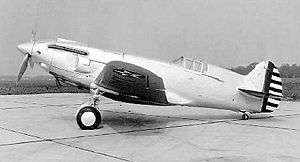Curtiss P-37
The Curtiss P-37 was a fighter aircraft made by Curtiss-Wright in 1937. A development of the Curtiss P-36 Hawk, the P-37 never entered production.
| P-37 | |
|---|---|
 | |
| Curtiss YP-37 | |
| Role | Fighter |
| National origin | United States |
| Manufacturer | Curtiss-Wright Corporation |
| First flight | April 1937 |
| Primary user | United States Army Air Corps (USAAC) |
| Number built | 14 |
| Developed from | Curtiss P-36 Hawk |
| Variants | Curtiss P-40 Warhawk |
Design and development
In early 1937, the USAAC ordered Curtiss to adapt one P-36 to the new liquid-cooled turbo-supercharged Allison V-1710 engine with 1,150 hp (860 kW). Designated Curtiss XP-37, the aircraft used the original Model 75 airframe with radiators mounted on the sides of the fuselage around the engine. The cockpit was moved far to the rear to make room for the radiators and the bulky turbocharger system, and to balance the aircraft. The aircraft flew in April 1937, reaching 340 mph (550 km/h) at 20,000 ft (6,100 m). Although the turbo-supercharger was extremely unreliable and visibility from the cockpit on takeoff and landing was virtually nonexistent, the USAAC was sufficiently intrigued by the promised performance to order 13 service test YP-37s and spares at a contract cost of $531,305.12.[1] Featuring improved aerodynamics and a more reliable turbo-supercharger, the aircraft first flew in June 1939. However, the powerplant remained unreliable and the project was cancelled in favor of another Curtiss design, the P-40.[2]
In early 1937, after realizing the Hawk 75 was inferior to more modern European designs, the USAAC ordered one P-36 to be modified with an Allison V-1710 inline engine. The prototype Hawk was fitted with a turbo-supercharged 1,150 hp (860 kW) Allison V-1710-11 engine as the XP-37 (company designation Model 75I). The cockpit was moved back towards the tail to make room for the massive supercharger, and the engine was cooled by two radiators on either side of the nose. Armament was one 0.30 in (7.6 mm) M1919 Browning MG and one 0.50 in (13 mm) M2 Browning MG mounted in the nose. The XP-37 was plagued with supercharger and visibility problems.[2]
A further 13 Model 75Is were ordered in 1938 under the designation YP-37. These differed from the XP-37 in having a V-1710-21 with a more reliable supercharger and an extended fuselage, but the project was cancelled after continued supercharger and visibility problems.[2]
Variants
- XP-37
- One aircraft built with a V-1710-11 engine.
- YP-37
- 13 aircraft built with a V-1710-21 engines and extended fuselage
Specifications (YP-37)
Data from Curtiss aircraft 1907-1947,[3] Baugher : Curtiss XP-37[4]
General characteristics
- Crew: 1
- Length: 32 ft 11.5 in (10.046 m)
- Wingspan: 37 ft 3.5 in (11.367 m)
- Height: 11 ft 1 in (3.38 m)
- Wing area: 236 sq ft (21.9 m2)
- Airfoil: root: NACA 2215; tip: NACA 2209[5]
- Empty weight: 5,592 lb (2,536 kg)
- Gross weight: 6,700 lb (3,039 kg)
- Powerplant: 1 × Allison V-1710-21 V-12 liquid-ciooled piston engine, 1,000 hp (750 kW)
- Propellers: 3-bladed Curtiss electric constant-speed propeller
Performance
- Maximum speed: 340 mph (550 km/h, 300 kn) at 10,000 ft (3,000 m)
- 331 mph (288 kn; 533 km/h) at 20,000 ft (6,100 m)
- Cruise speed: 305 mph (491 km/h, 265 kn)
- Range: 570 mi (920 km, 500 nmi)
- Service ceiling: 34,000 ft (10,000 m)
- Rate of climb: 2,920 ft/min (14.8 m/s)
- Time to altitude: 20,000 ft (6,100 m) in 8 minutes 30 sec
Armament
- Guns: 1 x 0.30 in (7.6 mm) M1919 Browning machine gun and 1 x 0.50 in (13 mm) M2 Browning machine gun
See also
Related development
References
| Wikimedia Commons has media related to Curtiss P-37. |
- "ARMY AIR CORPS BUYS PURSUIT AIRPLANES". Air Corps News Letter. Air Corps Munitions Building, Washington, D.C.: Information Division USAAC. XXI (1): 2. 1 January 1938.
- Bowers, Peter M. (1987). Curtiss aircraft, 1907-1947. London: Putnam. pp. 348–365. ISBN 9780851778112.
- Bowers, Peter M. (1987). Curtiss aircraft, 1907-1947. London: Putnam. p. 365. ISBN 9780851778112.
- Baugher, Joe. "Curtiss XP-37". www.joebaugher.com. Retrieved 22 March 2019.
- Lednicer, David. "The Incomplete Guide to Airfoil Usage". m-selig.ae.illinois.edu. Retrieved 16 April 2019.